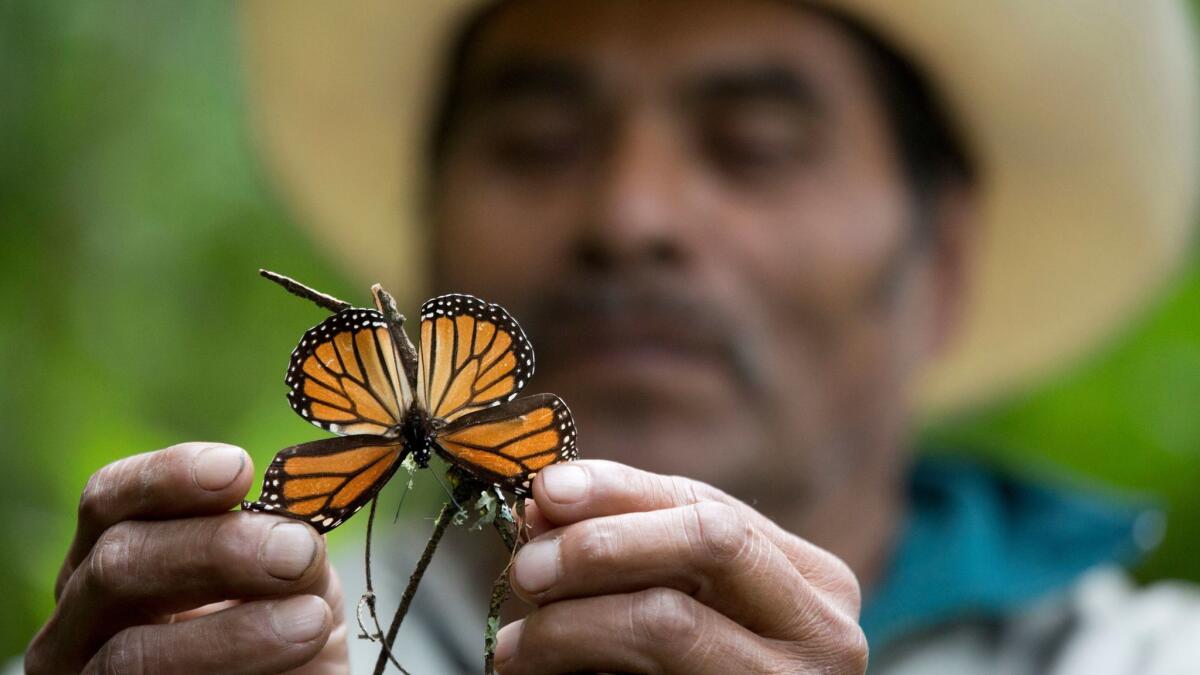Op-Ed: How tagging butterflies can help you tell what’s real and what’s fake

Facts, and reality itself, are under attack. President Trump calls anthropogenic global warming — about which there is no scientific doubt — a hoax. Days before the Congressional Budget Office released its scorecard for the new healthcare law, some politicians insisted that the nonpartisan numbers the agency produced could not be believed. Every day on cable TV, you can watch Americans go to war over what’s real and what’s fake.
Those alarmed by the battles and the prospect of drowning in bogus information are taking to the streets, calling their representatives in Washington and showing up at town hall meetings. But that sort of politicking may only serve to divide us further. To combat the forces of anti-reality, there’s a better, more unifying tool of civic engagement — citizen science.
The organized pursuit of science by amateurs is a little known but spectacularly successful phenomenon. Over time it has brought together people of all ages, creeds, backgrounds and political persuasions and enabled discoveries that were only made possible through their collective volunteer work.
Citizen science projects are run by university researchers, government agencies, conservation groups, medical centers and even prisons. The volunteers classify images, transcribe museum archives, tag birds and insects, measure river flows and take on dozens of other tasks that help professional scientists answer a particular question, establish a pattern or test a hypothesis.
Many of the discoveries helped by citizen science upended persistent misinformation or even falsehoods taken as truths.
To combat the forces of anti-reality, there’s a...unifying tool of civic engagement — citizen science.
Sailing was hazardous for centuries because of misunderstandings of ocean currents. Then in the mid-1800s, sailors from more than a dozen countries recorded detailed observations of winds and currents. Their reports, collated by a Navy officer, launched the field of oceanography and resulted in charts that made sailing safer and faster for all.
For years, people wondered how monarch butterflies survived cold northern winters. To solve the mystery, teachers and students in the United States and Canada began capturing and tagging the insects in the 1950s. The work was finally rewarded in 1976, when a researcher spotted a tagged monarch in Mexico, revealing the insects’ amazing 4,000-mile migration to the south.
In the early 2000s at North Carolina State University, where I now teach, biologists wanted to get a better handle on the bacteria we live with, especially the beneficial kind. The researchers mailed special cotton-swab kits to volunteers and asked them to sample specific parts of their homes. The swabs yielded a list of 7,726 types of bacteria, along with the news that a dog in the house increases its microbial count (which may explain why children with pet dogs have fewer allergies).
In 2014 in Flint, Mich., city officials told residents not worry about their discolored tap water. Skeptical Flint residents beset with illnesses initiated a partnership with scientists to examine the quality of their water. Their efforts proved that Flint tap water contained toxic levels of lead.
People get motivated to do things like swab their door frames out of simple curiosity or to solve a mystery. Their efforts can benefit society far beyond the data collected. Just as school activities, sports teams and community events build social capital and contribute to a functioning society, citizen science builds social-scientific capital — in other words, a fact-based populace.
I’ve encountered citizen-scientist bankers who turned from climate change skeptics into sustainability advocates, neighbors who sent an industry manager to jail for polluting their air, a community that accepted the weighty responsibility of managing federally designated threatened sea turtles, and online gamers who became ambassadors for science. These amateurs absorb the scientific method, and along with it, a reliance on evidence. They make inquiry a habit. Citizen science stitches fact-appreciative people into the fabric of society.
Federal agencies have had a major role in organizing and funding citizen science for decades, but persistent concerns about the acceptability of volunteered data, possible liability and potential displacement of employees hampered some projects. Advocates for citizen science were able to counter those concerns, and when the bipartisan American Innovation and Competitiveness Act passed in December, it included explicit authorization for federal agencies to carry out citizen science. As conventional science struggles for funding — and even supporters — in an anti-elitist era, Congress’ broad endorsement of citizen science is just one indicator of its unifying effect.
Thomas Jefferson noted that seeking truth is intertwined with democracy. “If a nation expects to be ignorant and free, ... it expects what never was or will be,” he wrote in 1816. Citizen science is a way to combat ignorance and to keep autocracy at bay. The more we encourage it — and the more we participate in it — the better our chances of achieving something we need now more than ever: a shared understanding of the world that will allow reality to prevail.
Caren Cooper is the author of “Citizen Science: How Ordinary People Are Changing the Face of Discovery.”
Follow the Opinion section on Twitter @latimesopinionand Facebook
More to Read
A cure for the common opinion
Get thought-provoking perspectives with our weekly newsletter.
You may occasionally receive promotional content from the Los Angeles Times.






